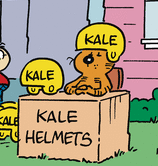|
Spergatory posted:I don't know why Chip's appearance is a surprise to anyone. He has a skinny white guy face and body to go with his skinny white guy voice. What were you expecting him to look like? Yeah, Chip is a skinny white guy, and Ironicus is a handsome black man. We all know this, even without looking.
|
|
|
|

|
| # ? Apr 26, 2024 15:14 |
|
Just found this today... The Humane Society of the United States -- an organization dedicated to animal protection -- has a webpage titled “What to Do About Beavers.” The problem these animals cause is, actually, a pretty simple one. Beavers build dams, which is a very good thing if they’re in a relatively rural floodplain -- but it’s a really bad thing if the beavers are in more densely populated suburbs or cities. Left unchecked, beavers in an area with a lot of humans can cause damage to trees and, in some cases, flooding. The Human Society therefore understands that it’s okay to take action against the beaver population at times. The organization suggests against trapping or shooting the animals, which (beyond being inhumane) is ineffective -- “it only creates a vacuum into which new beavers will move, often sooner rather than later.” Instead, the Humane Society offers a few suggestions, such as fencing off trees and painting the trees with an abrasive coating. They do not, however, suggest parachuting urban beavers into rural areas. But, surprisingly, they probably should. (Do not try this at home.) In 1948, Idaho had a beaver problem -- as people moved into old beaver habitats and started building houses, the tree-chomping creatures became an increasingly sinister menace. The Idaho Fish and Game department wanted to relocate those city beavers to the uninhabited (by humans, of course) parts of the state. A man named Elmo W. Heter first tried to collect the beavers and put them on mules, but this wasn't successful -- as he’d later recount in a paper (pdf here) on his efforts, the mules "become spooky and quarrelsome when loaded with a struggling, odorous pair of live beavers." Undeterred, Heter tried a new approach. He took an older, male beaver who would soon be dubbed Geronimo and started dropping it from airplanes. Heter explained the process in the above-linked paper. First, using weights, they tested crates until they found a type which would stay closed until reaching the ground. Then, Geronimo's job began -- Heter dropped him "again and again" from a plane and onto the field below, in order to further determine the appropriate drop height and to test the crates carrying the rodents, as seen above (via Boise State Public Radio). Once Geronimo had safely landed enough times for Heter's liking, the beaver relocation went into full swing. It was, by and large, a success: In the fall of 1948, 76 live beavers were dropped with only one casualty. On the first drops, light weight lashings were used on the sling ropes, and one of these broke before there was sufficient tension from the shroud lines to hold the box closed. One beaver worked his head through the small opening thus made for him, and managed to climb out onto the top of the box. Even so, had he stayed where he was, all would have gone well; but for some inexplicable reason, when the box was within 75 feet of the ground, he jumped or fell from the box. Observations made late in 1949 showed all the airborne transplantings to be successful. Beavers had built dams, constructed houses, stored up food, and were well on their way to producing colonies. Heter estimated that transporting four beavers in this fashion could be accomplished at the relatively low price of $30 a quartet (about $300 in today's dollars) and concluded that "the savings in man hours, and in the mortality of animals, is quite evident," in case anyone wanted to repeat the process. And, according to Smithsonian magazine, the air-dropped beavers' descendants still populate the region today -- so the idea has staying power, too. But don't expect any more beavers to be tossed out of airplanes any time soon -- even though the Humane Society doesn't specifically frown on the idea, they do suggest that we "try to live peacefully with these animals." And that, likely, precludes parachuting them into parts unknown.
|
|
|




